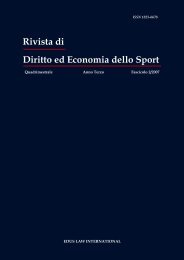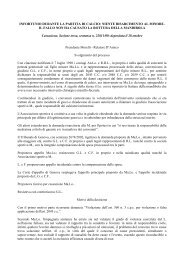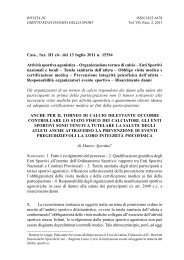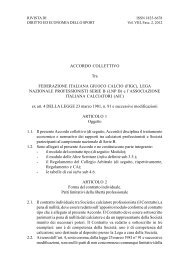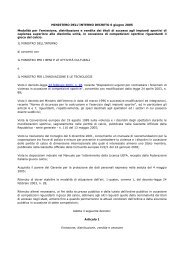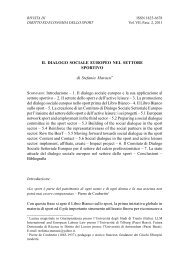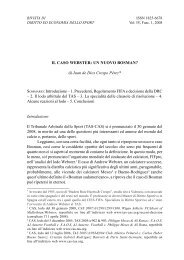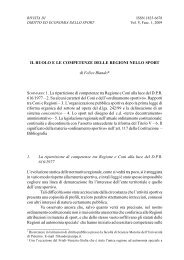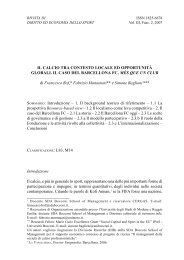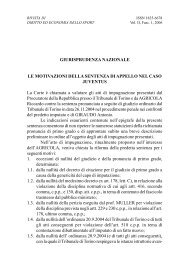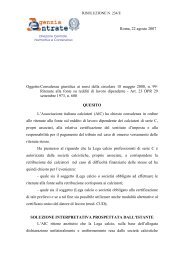European Sports Law and Policy Bulletin THE BERNARD ... - Slpc.eu
European Sports Law and Policy Bulletin THE BERNARD ... - Slpc.eu
European Sports Law and Policy Bulletin THE BERNARD ... - Slpc.eu
Create successful ePaper yourself
Turn your PDF publications into a flip-book with our unique Google optimized e-Paper software.
122 Rob SimonsIn 2009 FIFA has revised its regulations, especially in the field of theprotection of minors. Not only article 19 of the FIFA RSTP was extended <strong>and</strong>amended, also other measures were taken to improve the protection of minors,e.g. the introduction of a Players’ Status sub-committee, a Transfer MatchingSystem <strong>and</strong> partially revised training compensation provisions.This chapter will step aside the Bernard case <strong>and</strong> will take a deeper lookinto the freedom of movement of minors <strong>and</strong> the new FIFA regulations regardingminors. Attention will be given to the organization of sports, the freedom ofmovement <strong>and</strong> the FIFA Regulations concerning the protection of minors, includingits new measures. Moreover UEFA’s homegrown rule <strong>and</strong> UEFA’s resolution toprohibit transfers in Europe under the age of 18 will be discussed. Furthermorerelevant in the protection of minors is the <strong>European</strong> Commission’s study on sportagents. 2 Finally the <strong>European</strong> public law provisions will shortly be discussed throughreports from the <strong>European</strong> Commission <strong>and</strong> the <strong>European</strong> Parliament.2. Organization of sportThe major role FIFA plays in football is due to the pyramid structure of football.Thereby, as a result of the autonomy of sports organizations <strong>and</strong> the «specificity»of sports, sports organizations have a certain margin to make up rules <strong>and</strong>regulations.2.1 Pyramid model of SportThe current model of organization of sport in Europe (the so-called «<strong>European</strong>Sport Model») tends to be represented by means of a pyramid. The wide basecomprises the pool of players, who are organized to form clubs, which in turn aremembers of national associations that are responsible for organizing championships<strong>and</strong> governing football at national level. The national associations then group togetherin continental associations. Finally, the peak of the pyramid represents theinternational association. 3<strong>Sports</strong> associations thus usually have practical monopolies in a given sport<strong>and</strong> may thus normally be considered dominant in the market of the organisationof sports events under Article 82 EC 4 (currently Article 102 TFEU).An example of the application of the pyramid model can be seen ininternational transfers. In case a player wants to move to another country to playfor a (foreign) club, not only the clubs need to agree on the transfer, also the____________________2EUROPEAN COMMISSION, KEA – CDES – EOSE: Study on <strong>Sports</strong> Agents in the <strong>European</strong> Union,November 2009.3R. BLANPAIN, M. COLUCCI & F. HENDRICKX, The Future of <strong>Sports</strong> <strong>Law</strong> in the <strong>European</strong> Union:beyond the EU Reform Treaty <strong>and</strong> the White Paper, Alphen aan de Rijn, Kluwer <strong>Law</strong> International,2008, 96, footnote 1.4Commission Staff Working Document, The EU <strong>and</strong> Sport: Background <strong>and</strong> Context accompanyingdocument to the White Paper on Sport, 68.



